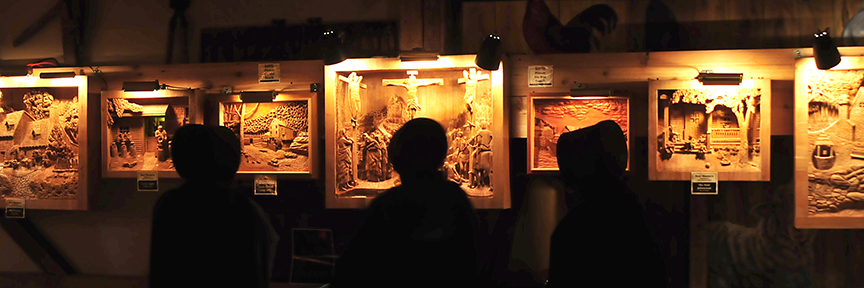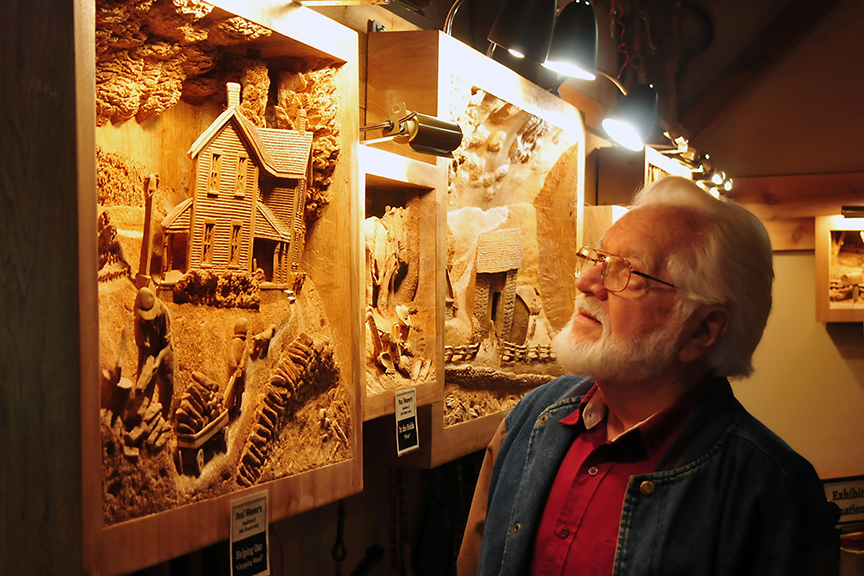 Editor’s Note: This article was originally published in January of 2014. We’re happy to announce that Paul Weaver’s wood carvings are back on display in our store. We’ve added a video and photos below for your enjoyment, but as other customers have told us, the photos don’t do them justice. This is something you’ll want to see in person!
Editor’s Note: This article was originally published in January of 2014. We’re happy to announce that Paul Weaver’s wood carvings are back on display in our store. We’ve added a video and photos below for your enjoyment, but as other customers have told us, the photos don’t do them justice. This is something you’ll want to see in person!
When you put simple tools, wood and a craftsman together, the results can be amazing. Take the deep-relief woodcarvings currently on display at Lehman’s in Kidron, Ohio.
Carved by Holmes Country resident Paul Weaver, each piece develops from blocks of butternut (or white walnut) wood, and shows glimpses of a simpler way of life.
Weaver’s been working with wood his whole life. About 23 years ago, he took up whittling, and then a workshop with master carver David Bennett changed him forever. “I went to a school with David Bennet, and I was a week with him. He taught me how to water, to do clouds or textures.” Weaver, who is Amish, came home and started doing his own deep relief carvings.

“I started with mahogany, you know, but then I went to butternut. It’s easier to work with, using hand tools. You’ll get better detail. Basswood, hardwoods, those are brittle on the details, and they’ll break on you.”

By day, he’s a furniture maker, supplying bedroom suites for many of the furniture stores that dot Amish country. But at night, in the top floor of his shop, he’s an artist.
“I don’t sell the carvings, it’s basically still a hobby for me,” he says. He uses the rural themed paintings of John Sloane, Thomas Kincaid, and Michael Humphries as inspiration for his carvings. “Sloane, he does beautiful work. And I think he’s fascinated by the Amish!” Weaver chuckles and goes on. “He shows milking cows, cutting wheat…There’s action in his pictures. They’re my favorite to carve from. His proportions are so perfect, there’s never an error in his work.”
He doesn’t consider himself an artist, though. “Oh, no. I can’t draw, you see. I am so appreciative of the artists that I see. They have a true gift. I can’t draw a bit. My nephew, now, he can draw. He drew me a picture once for a carving, and it was beautiful, and I used that.”
Weaver is modest about his own gift. “Well, I feel it’s a God-given talent to me, because I’m not very smart. Its relaxing for me.” He goes on to say that folks can think what they want, fuss at each other, but he’d rather be carving. “It puts me in a different place, is how I can describe it.” When he’s in that shop, with his hands on his tools, he’s in a world of his own.

At some point in the future, he’d like to stop furniture making and carve full time. “One of the main things is that I never sold any, is that as soon as you do something as soon as you do it for someone, you lose your freedom. The only way I’d sell it is if I did it for myself first.” He feels carving to order would restrain him, limit his ability to create freely and joyfully.
He literally builds his pieces from the ground up. Each relief sculpture is carved from a laminated stack of butternut that Weaver glues up himself. “Sure, I have the tools right here.” He uses ordinary carpenter’s glue and wood clamps to build up the butternut blocks to the appropriate thickness. “I’ve done carvings on an inch and a half (block), but I’ve never gone any thicker than seven inches,” he says.
In his very early pieces, Weaver actually applied some elements to the carving. “Things like window slats, those were difficult.” Now, however, he no longer does that. “It’s all carved out, every bit. That Crucifixion, that is all one piece. It took me six months.” After he’s sketched in the main figures, he uses an electric drill press to rough out the carving, but after that, it’s all hand tools. “I use drawknives and chisels for seventy-five percent of it. I just take my time and carve.”

Family plays an important role in Weaver’s work. He cites his wife Linda as his best critic and help, saying she can “just tell when something isn’t right.” Weaver’s youngest son has what his father fondly calls “an artistic eye,” and between the two of them, he says, they’ve helped him work out problems with proportions.
Lehman’s founder Jay Lehman has been friends with Weaver’s brother for years. “Yeah, they played cards together, and we showed him my carvings. Then Jay got after me to show them for a fundraiser for handicapped children.” After that showing, Lehman’s president couldn’t get the gorgeous woodworks out of his mind.
“I’m so pleased to have the opportunity to work with Galen. And the people at the store are so kind, so wonderful. It’s a pleasure to show my carvings there. I’m hoping to be able to be there, with a started carving in a month or so, to show the people, so they can see how it works,” said Weaver.
He notes that it’s hard to carve in public: “I’ve had places that I’ve gone before, and when you’re talking to the people, you just can’t concentrate to use a chisel, you know. So I’ll have a new carving there, as an example, to show how it works.”
“I’m looking forward to meeting people, meeting other carvers. Deep relief isn’t something everyone does, so when I can get up there, I hope to compare ideas, see how other folks are doing things. There aren’t any big secrets. It’s always a learning process.” He’s hoping that he can interest more young people in learning the technique. “There’s not a whole lot of folks going into deep relief. I’d like to see more people doing that.”































[…] When you enter, the registers are on your right. As you head to the left, if you make a sharp right there is a room of deep-relief woodcarvings on display by Paul Weaver. You can learn more about these stunning works of art by clicking here. […]